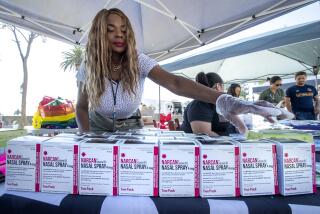Teens’ Abuse of Legal Drugs on the Rise
- Share via
While anti-drug messages focus primarily on marijuana and alcohol, educators and police report that prescription pills such as antidepressants and painkillers are gaining favor on school campuses.
Abuse of such medicines sent hundreds of youngsters to hospital emergency rooms nationwide last year and has awakened parents to the fact that the medicine cabinet can be a gateway to childhood drug problems.
While many of the pills come from family prescriptions, authorities said some teens are purchasing the drugs in bulk and illegally selling them to classmates.
Three students at Los Alamitos High School passed out in class last week after taking the muscle relaxant Soma, prompting a police investigation that led to the arrest of three others who allegedly sold the pills.
Such cases are increasingly common, prompting school districts and law enforcement to focus more attention on this emerging form of teen substance abuse.
Nationally, the number of youngsters abusing prescription painkillers alone rose from 125,000 in 1990 to an estimated 718,000 in 1998, according to a report by the U.S. Department of Health and Human Services.
Another federal report estimated that in 1999 more than 700 youngsters were treated at hospitals for overdoses of just one type of painkiller, a sharp increase over the last five years.
Some teenagers say the drugs are so plentiful that students sometimes bring handfuls to school and share them with others. At Corona del Mar High School, for example, several students said they’ve seen classmates pop Vicodin, a powerful and addictive painkiller.
“I know a lot of people steal it from their parents, and they just give it away,” said a 16-year-old sophomore.
Experts said marijuana and alcohol remain the top drugs of choice for teens but find increasing prescription pill abuse troubling because of the easy accessibility and low public awareness.
“It’s a chronic situation,” said Kathy McTaggart, anti-drug coordinator for the Santa Monica-Malibu Unified School District. “Ritalin is a pretty common drug that is abused. Kids are taking it and will share it with others. It’s an experimental way of getting high.”
Even strict school zero-tolerance policies may have inadvertently contributed to the problem, as some youngsters now beat alcohol-screening devices at proms and other school events by taking pills instead.
“Someone can take a couple of these pills, have an intoxicated feeling and there will be no smell of alcohol or marijuana,” said Fullerton Police Sgt. Joe Klein. “They can go undetected by the untrained observer.”
Some schools and police departments now train their personnel in recognizing the symptoms, which can range from grogginess to hyperactivity. In south Orange County, authorities are citing increasing numbers of youngsters for driving under the influence of prescription pills, sheriff’s Deputy Jim Rubio said.
Prescription pills popular with students include the amphetamine-like drug Ritalin, tranquilizers such as Valium and Xanax, and Vicodin.
Ritalin appears to be the easiest to obtain on campuses, experts say, because many students who are prescribed the drug for hyperactivity often give or sell the pills to others.
At one middle school in the Capistrano Unified School District, officials said three children have been expelled over the last two years for giving Ritalin to fellow students. In Newport Beach, officials report instances of teens taking Ritalin to lose weight--an issue that student government leaders have vowed to address.
Soma, a muscle relaxant, has also surged in popularity. Last year at Dana Hills High School, three students were taken to a hospital after teachers noticed the groggy symptoms associated with the drug. All three students were expelled under the school’s zero-tolerance drug policy, according to Ron Dempsey, executive director of pupil services at Capistrano Unified School District.
Obtaining pills is not a problem. Some students make runs to Mexico, where many prescription drugs can be bought legally, and in bulk. Deputies earlier this year arrested a Dana Point teen for allegedly distributing Valium to classmates at a park near Dana Hills High. At the boy’s home authorities discovered more than 100 tablets, which they believe he got through a connection in Mexico, Rubio said.
Detectives in Los Alamitos are investigating how a 16-year-old Seal Beach student obtained more than 100 Soma tablets, which he is accused of distributing on campus.
Often, the drugs come from the family medicine cabinet or other easily accessible places where kids can pilfer parents’ pill bottles.
At an Oxnard elementary school, three 10-year-old boys were hospitalized after taking sleeping pills and antidepressants that one of the boys got from his mother’s purse. School officials said the boy told his friends: “Close your eyes and I’ll give you candy.”
The drugs appeal to children for various reasons.
For one, pills are perceived as “clean” drugs by youngsters who have been turned off to other substances by relentless anti-drug campaigns, officials said. No longer is there a need for nighttime runs for meetings with shady pushers in dangerous neighborhoods.
Pills are also widely perceived as giving “safer” highs than marijuana, cocaine and other drugs, whose ill affects have been widely publicized and led to the deaths of major public figures.
“Because of the wondrous production of new cures and medications, we live in a world where medications are all around us in a way that they weren’t just a few decade ago,” said Peter Kerr of Phoenix House, the nation’s largest nonprofit operator of substance abuse treatment centers. “So when another kid makes the offer of a pill, it’s not as alien a thing.”
Officials urge parents to keep prescription pills out of reach of their children and carefully monitor all bottles to make sure no tablets are missing.
Parent Martha Fluor knows the dangers firsthand.
Fluor, a board member with the Newport-Mesa Unified School District, said her teenage son abused Ritalin without her knowledge. His doctor prescribed the medication after diagnosing him with attention deficit disorder.
“It was closely monitored and we kept those drugs under lock and key,” Fluor said.
But she said her son became an abuser while at boarding school.
“We need to be hyper-vigilant and very educated about prescription drugs,” she said. “There is always a chance for illicit use.”
(BEGIN TEXT OF INFOBOX / INFOGRAPHIC)
Teen Pain Pill Abuse Rose Sharply in ‘90s
First-time abuse of pain relievers by teenagers in the United States jumped dramatically in the past decade from 125,000 users in 1990 to 718,000 in 1998. The rate per 1,000 people (ages 12-17):
1965: 2.7
1998: 32.4
Source: U.S. Dept. of Health & Human Services
More to Read
Sign up for Essential California
The most important California stories and recommendations in your inbox every morning.
You may occasionally receive promotional content from the Los Angeles Times.











